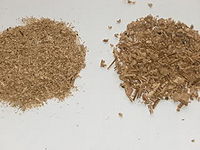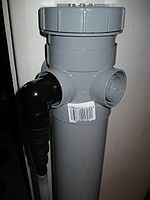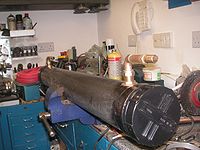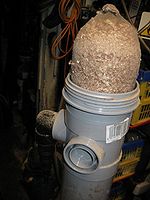Difference between revisions of "Dry washing"
m (Add to biodiesel catagory) |
(Reformatted) |
||
| Line 1: | Line 1: | ||
[[File:Ecopure_vs_hardwood.jpg|200px|thumb|right|Ecopure and hardwood drywash medium]] | [[File:Ecopure_vs_hardwood.jpg|200px|thumb|right|Ecopure and hardwood drywash medium]] | ||
| − | |||
| − | |||
An alternative to [[Water Washing]] is dry washing, so called because no water is used in the removal of soaps from the biodiesel. | An alternative to [[Water Washing]] is dry washing, so called because no water is used in the removal of soaps from the biodiesel. | ||
| Line 7: | Line 5: | ||
This is considered a "final polish" stage, after the majority of soap has been allowed to settle out naturally following Demething. | This is considered a "final polish" stage, after the majority of soap has been allowed to settle out naturally following Demething. | ||
| − | + | __TOC__ | |
| − | == Ion Exchange == | + | ==Ion Exchange Resin== |
Because the ASTM D6751 standard for biodiesel has a greater tolerance for [[Free Fatty Acid]] content than soap, an ion exchange resin can be employed to convert any remaining soap in the fuel into Free Fatty Acids. | Because the ASTM D6751 standard for biodiesel has a greater tolerance for [[Free Fatty Acid]] content than soap, an ion exchange resin can be employed to convert any remaining soap in the fuel into Free Fatty Acids. | ||
| Line 15: | Line 13: | ||
This is, however, to the detriment of the acid number of the final product. | This is, however, to the detriment of the acid number of the final product. | ||
| − | == Hardwood == | + | ==Hardwood== |
If the biodiesel is passed through a tower packed with hardwood shavings, the soaps becomes trapped within the course structure of the shavings and sawdust. Any trace [[Methanol]] is also absorbed by the medium. | If the biodiesel is passed through a tower packed with hardwood shavings, the soaps becomes trapped within the course structure of the shavings and sawdust. Any trace [[Methanol]] is also absorbed by the medium. | ||
| Line 21: | Line 19: | ||
Typically, a 10 litre tower should have biodiesel pumped or gravity fed through it, bottom to top, at a rate of 3 litres per minute. If the fuel is well settled before filtering, 10 litres of medium should be capable of filtering 1000 litres of biodiesel. | Typically, a 10 litre tower should have biodiesel pumped or gravity fed through it, bottom to top, at a rate of 3 litres per minute. If the fuel is well settled before filtering, 10 litres of medium should be capable of filtering 1000 litres of biodiesel. | ||
| − | + | <gallery caption="Home made hardwood towers" widths="200px" heights="200px" perrow="3"> | |
| − | |||
| − | <gallery caption="Home made | ||
File:Drywash_tower_solvent_weld.jpg|A tower made out of 110mm drain pipe and stepped solvent weld tails | File:Drywash_tower_solvent_weld.jpg|A tower made out of 110mm drain pipe and stepped solvent weld tails | ||
File:Drywash_julian.jpg|Another tower with tank connectors for inlet and outlet | File:Drywash_julian.jpg|Another tower with tank connectors for inlet and outlet | ||
Revision as of 01:36, 27 November 2010
An alternative to Water Washing is dry washing, so called because no water is used in the removal of soaps from the biodiesel.
This is considered a "final polish" stage, after the majority of soap has been allowed to settle out naturally following Demething.
Contents
Ion Exchange Resin
Because the ASTM D6751 standard for biodiesel has a greater tolerance for Free Fatty Acid content than soap, an ion exchange resin can be employed to convert any remaining soap in the fuel into Free Fatty Acids.
This is, however, to the detriment of the acid number of the final product.
Hardwood
If the biodiesel is passed through a tower packed with hardwood shavings, the soaps becomes trapped within the course structure of the shavings and sawdust. Any trace Methanol is also absorbed by the medium.
Typically, a 10 litre tower should have biodiesel pumped or gravity fed through it, bottom to top, at a rate of 3 litres per minute. If the fuel is well settled before filtering, 10 litres of medium should be capable of filtering 1000 litres of biodiesel.
- Home made hardwood towers



